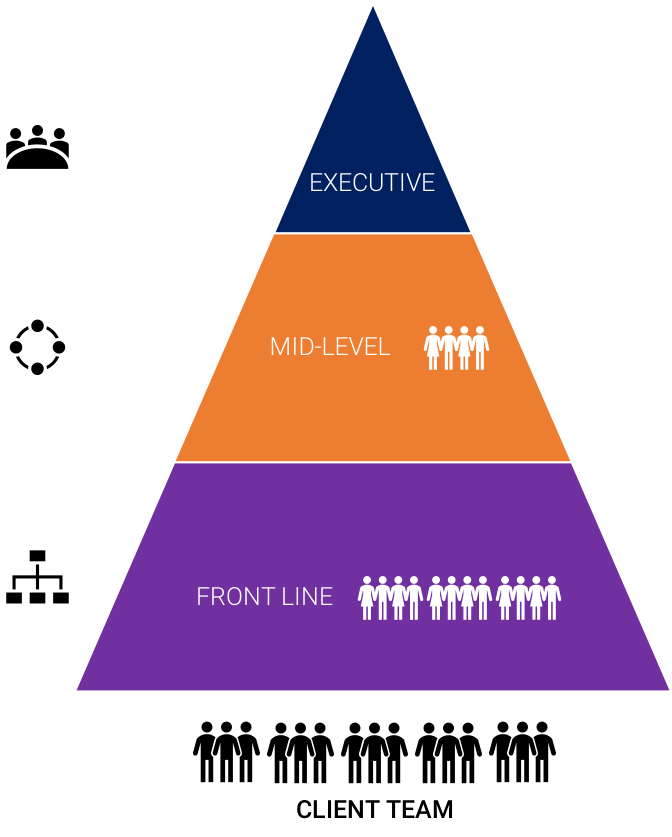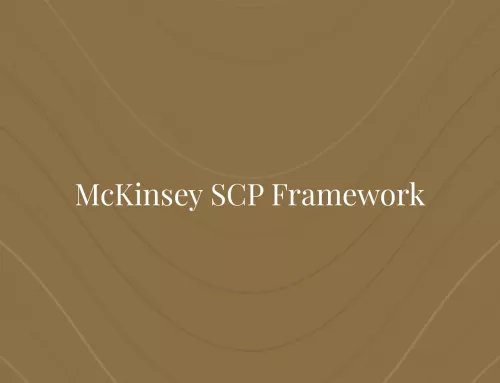Most professional services firms, including Management Consulting firms, have levels of leadership. The terms – Managers & Leaders are quite loosely used across the industry. However, there are material differences in the job description and purpose[1]. Across the board, consultants assume different leadership forms depending on their levels in the consulting firm. Correspondingly, there are 3 broad categories:
- Frontline Leadership
- Mid-level Leadership
- Executive Leadership

Frontline Leadership
These are the organisation’s team leads and supervisors. Frontline managers are responsible for day-to-day team management. They oversee the operational aspects of client delivery, such as staff attendance, morale, compliance with policies, etc. They work on specific deliverables required to deliver the project, while staying closely connected to the customer. These are usually staff members, typically young, and early in their careers. The management style at this level is usually command-and-control. Consultants learn the essential human aspects, such as building client trust, get work done through influence, etc. at this level. Sometimes, you may need to manage people that were previously your peers.
From the Bain website:
Bain managers, most often promoted from within the firm, serve as leaders for both case teams and clients. Managers take responsibility for cracking clients’ toughest problems and presenting insights in a compelling way that convinces the client to take action. Internally, managers have a seat and a voice at the leadership table; you’ll play a pivotal role in the office as you fulfill various leadership duties, increase practice-area expertise, and support associate consultants and consultants. Successful managers move on to the role of principal.
Likewise, from the BCG website:
BCG project leaders have developed the experience and leadership skills to direct diverse teams of consulting talent. Your role: Help those teams flourish by guiding their efforts, directing their talents, and expanding their knowledge and skills to deliver strategic and sustainable solutions for our clients.
Mid-level Leadership
These are the Managers, Senior Managers and / or Associate Partners / Directors in a professional services firm. This group is more connected with the business goals. Correspondingly, they spend time on both, project delivery and project acquisition (sales) activities. However, their primary focus is on driving teams to realise the goals of Executive Leadership (Partners). Mid-level leaders spend a significant portion of their time managing teams, but are often drawn upon to assume more strategic responsibilities. These are activities, such as handling reporting, setting up practices / growth initiatives, participating in steering meetings, etc. This group requires a broad set of skills, both technical and managerial at a higher level of abstraction than the frontline leaders. The management style at this level is consultative with significant interaction among peers at this level.
Again, from the Bain website:
Principals take a big-picture approach to solving our clients’ toughest business problems. Because principals straddle the roles of manager and partner, their responsibilities range from inspiring and guiding a team on a day-to-day basis to cultivating the Bain relationship with senior clients—from owning a strategic vision to compelling clients to action. Bain principals grow increasingly adept at driving clear hypotheses, breakthrough analyses and actionable strategic insights for organizational and operational improvement. Principals are most often promoted internally from the manager role and are considered future leaders of the firm whose next step is the role of partner.
Likewise, from the BCG website:
As a BCG principal, you will focus on building client relationships that are strong and lasting. You will have a growing role in thought leadership, team mentoring, and business development. Clients will seek your advice on business issues that extend beyond the immediate scope of your project work. Thus, you often help them define the strategic direction of their organizations.
Executive Leadership
These are the leaders in the organisation that drive strategy. These senior leaders set the business goals and revenue targets. They are largely accountable sales and business development, which they also usually delegate to their mid-level directs. The primary responsibility of this set of leaders lies in growing revenues, developing their practise, and cultivating their directs to assume additional responsibilities. These leaders invest a significant portion of their time in devising strategies, thinking about the future prospects for the organisation, and monitoring the corporate culture. Unlike the mid-level manager, who has a span of influence that affects a handful of people, Executive Leaders’ influence usually span tens to hundreds of people. The management style at this level is usually collaborative among the peer group.
Again, from the Bain website:
Nomination to partner is a formal acknowledgement of personal merit and accomplishment. As a Bain partner, you’ll have considerable responsibilities:
- Develop lasting client relationships and build business success stories
- Be a major contributor to the growth of the company, both internally and externally
- Be accountable, along with your case teams, for defining innovative strategies and achieving results
- Play fundamental roles in key internal processes such as training, recruiting, coaching and social corporate responsibility
- Be an acknowledged expert in at least one capability and one industry
Bain partners are typically chosen from within the firm’s principal group.
Likewise, from the BCG website:
BCG’s partner group defines the culture and strategic direction of BCG and makes all management decisions for the firm. Partners are our intellectual leaders, bringing deep experience to our clients and inspiring innovation throughout our company. As a partner, you will drive BCG’s growth and help build the teams to meet tomorrow’s client issues and challenges.
References




